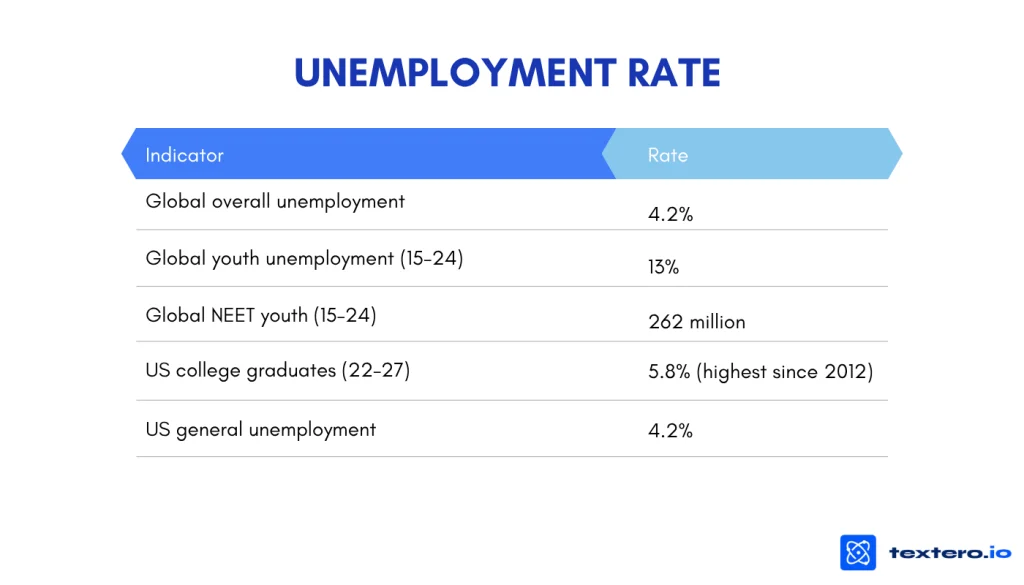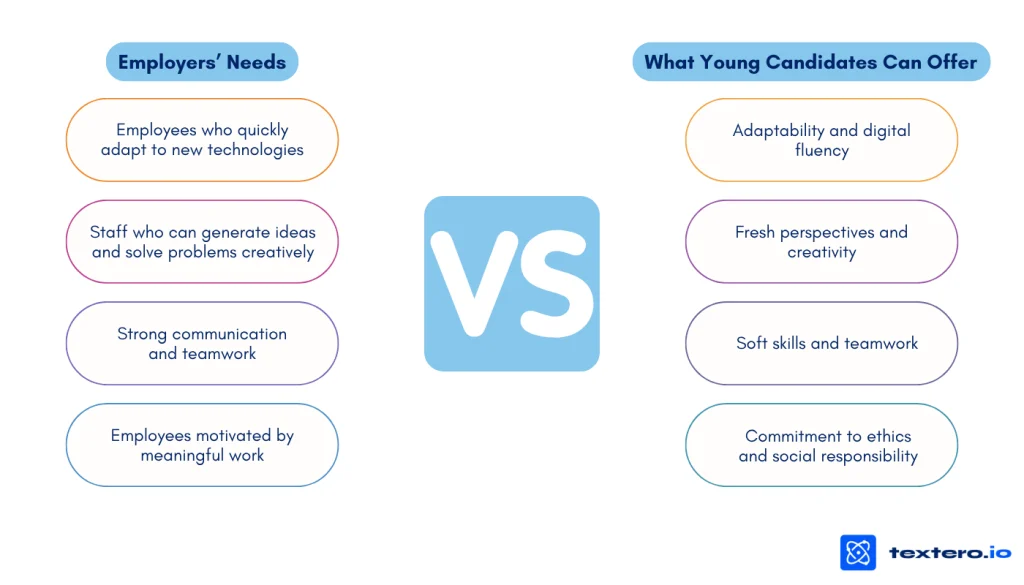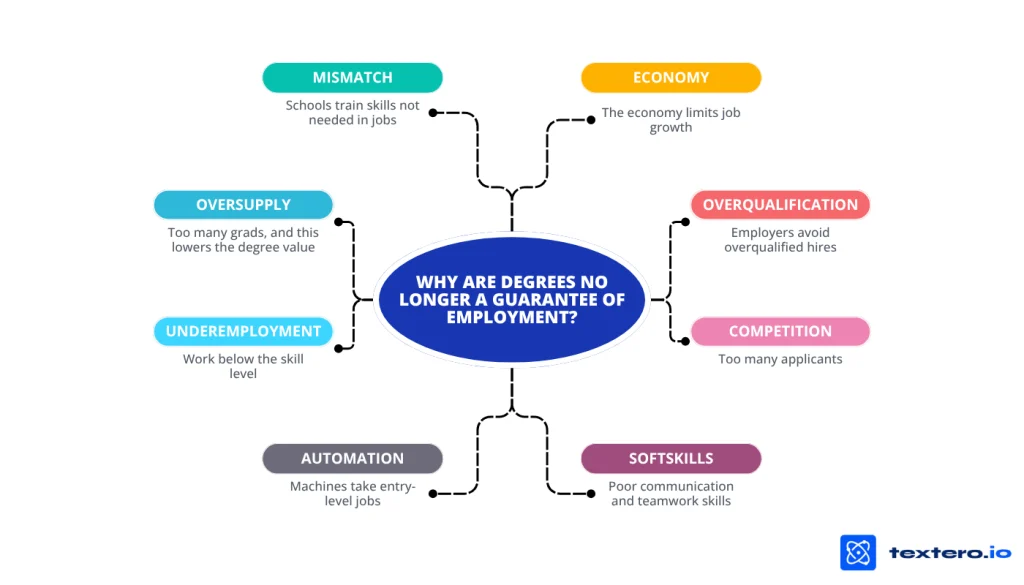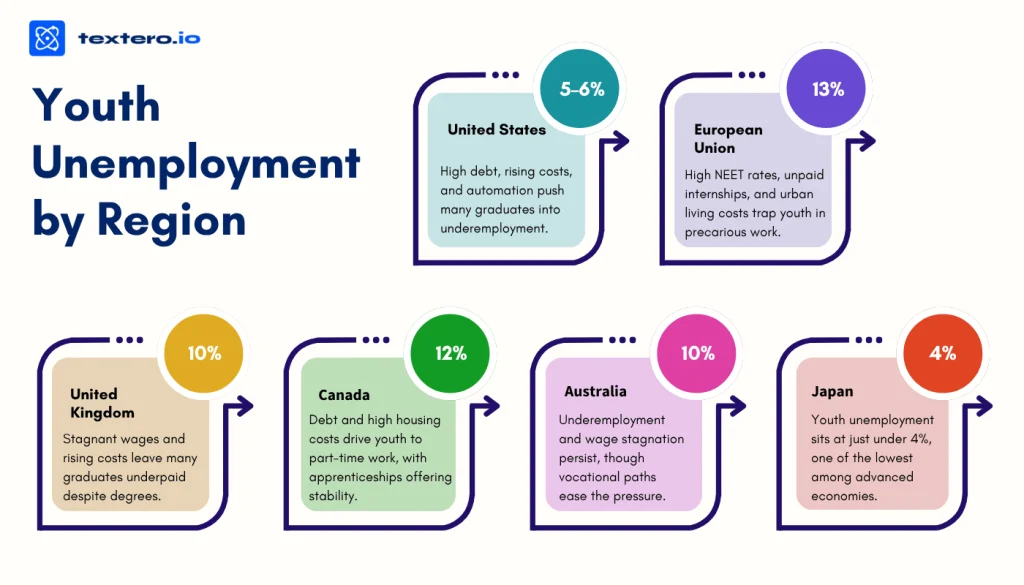Why Young People Struggle in the Job Market: A Data-Driven Look

Today, the question of employment is pretty sharp for college students because it covers a lot of issues that young adults have to solve. Of course, some students decide to get a job because they want to get experience, but for the predominant part of the learner population, a job is a way to make ends meet and solve problems, like living expenses, gaining practical experience, etc.
Another question is the fact that the job market has become pretty competitive, and with modern technologies, most experts are no longer in demand because of AI. In this article, we will dive into the struggles students face in the job market, what issues they have to handle, and how they can get the most out of it.
Breaking Down Stereotypes
Despite the overall unemployment rate among the general population being around 4.2% in July 2025, young adults continue to struggle disproportionately. Global youth unemployment remains at about 13%, with a lot of young adults neither working nor studying. In the US, unemployment for college graduates hit 5.8%, the highest level since 2012.

Labor Market Transformation: Automation, the Gig Economy, and Sector Shifts
Today, the labor market has changed, and this is one of the most important factors that has led to unemployment among college learners. So, what has changed in the job market, and how has this affected candidates?
Automation
It is no secret that automation, as well as AI, is reshaping task content. Across OECD economies, about 28% of jobs suffer from the highest risk of automation. Moreover, employers expect rapid task changes this decade: The WEF Future of Jobs 2025 survey of 1,000+ firms anticipates wide workforce transformation by 2030, the reason being AI diffusion. The OECD Employment Outlook 2025 states that policymakers highlight complementarity and the retraining of human skills rather than pure substitution.
The Gig Economy
In an EU survey, 3.0% of people aged 15–64 had done at least one hour of digital-platform work in the prior 12 months, with higher participation among tertiary-educated workers. According to the Bureau of Labor Statistics’ Contingent Worker Supplement, in the United States, 10.2% of workers held “alternative arrangements” as their main job in 2023, and 4.3% were in contingent jobs. These forms of employment can expand flexibility, but they often sit outside standard protections and heighten the relevance of various debates on benefits.
Sector Shifts
Macro transitions are shifting labor across industries. Net-zero policies are tilting demand toward clean energy and efficiency roles. As a result, global jobs reached 16.2 million in 2023, compared to 13.7 million in 2022; at the same time, according to the IRENA-ILO Renewable Energy and Jobs 2024 review, solar PV alone accounts for 7.1 million positions. OECD analysis also finds that while total employment may remain stable, many jobs are still moving from high- to low-emissions activities with specific reskilling needs. Demographics and care demand are also essential. Thus, in the USA, healthcare occupations are projected to add about 1.9 million openings per year from 2023 to 2033, which signals that there will be persistent shortages if training lags. These shifts make workforce development decisive for ensuring inclusive outcomes.
Skills Gap: What Employers Demand vs. What Candidates Offer
As we have already mentioned, employers have become more demanding because no one wants to pay extra salaries if they can use modern technologies for the same tasks humans have been recently completing. As a result, companies do not want to hire people who will do simple work; they would rather use AI and hire only those experts with highly professional skills. But at this point, we face the question of, “How can young adults gain this experience if they can’t find a job to start their career?” Thus, let’s take a closer look at what employers seek today, and what candidates can offer.
What Do Employers Demand?
- Advanced human skills. Over 28% of organizations report that new roles require updated skills; in this list, we can see data analysis, AI, and cybersecurity. Yet 78% say systems/resource management, such as complex problem-solving as well as strong decision-making skills, are critical and pretty hard to find in candidates.
- Closing the skills gap through upskilling. Employers are facing a troublesome skills gap. Today, 87% of employers report mismatches, with 50% of all employees needing reskilling by 2025. Most understand that investing in training is vital for growth.
- Demand for AI-fluent talent. AI-related hiring is growing 30% faster than general rates. By 2030, 70% of job skills will be impacted by AI. It is no secret that employers increasingly expect AI competency.
- Skill-based hiring pays less attention to degrees. In UK data, AI-role postings rose 21% from 2018-2023, while university-degree requirements declined by 15%. Today, we can see that employers favor demonstrable skills over formal credentials, offering a 23% premium for AI skills.
- Scalable, transparent skills-based hiring systems. Adopting skills-based hiring can reduce cost-to-hire by 70–80%, decrease training time by up to 75%, and improve productivity. It allows applicants to showcase improvements and mobility across different roles.
What Can Candidates Offer?
- Adaptability and digital fluency. Today, young candidates offer the ability to quickly learn and apply new technologies, be it AI, data analysis, or collaborative software. The youth are predominantly comfortable with the digital tools that can help organizations stay competitive and adopt various innovations faster. According to the World Economic Forum, 50% of all employees will need reskilling by 2025 because of the value of tech-ready talent.
- Fresh perspectives and creativity. Young professionals often bring new ideas and innovative approaches to problem-solving, and such exposure to current trends and social media insights allows employers to develop their products as well as improve their marketing strategies and services.
- Soft skills and collaboration. Young adults are not only digitally fluent; they also demonstrate strong teamwork as well as adaptability. They can easily bridge multigenerational teams and enhance organizational culture due to their flexibility.
- Commitment to purpose and social responsibility. Many young candidates seek meaningful contributions and care about company ethics and DEI practices. Employers gain employees who are engaged and proactive. Surveys show over 80% of young talent value purpose alongside career growth.
- Learning agility and continuous growth. Young workers are often ready to keep learning, get certifications, and upgrade their skills. Employers benefit from such a mindset because it reduces training gaps and supports internal mobility. This way, teams can adapt to technological or market changes rapidly and effectively.

Education-to-Work Mismatch: Why Degrees Don’t Always Lead to Jobs
Oftentimes, we see students choose between various ways of getting professional knowledge. As before, young adults can study at colleges and universities, but now there is also an option of taking courses that give the same information yet require much less time. This issue has arisen because of the idea that a degree is no longer a guarantee that one will be employed.
Outdated Curricula
Unfortunately, many degrees emphasize theory over practice, and as a result, graduates leave unprepared for real demands. Many employers report a mismatch between academic focus and workplace needs, especially in digital and AI literacy. In the UK, graduate job openings have plunged, while universities lag in embedding job-relevant digital skills into their curricula.
Oversupply
When too many graduates compete for too few relevant roles, oftentimes, the value of a degree diminishes. Today, credential inflation pushes job applicants toward overqualification; at the same time, degrees serve as formalities rather than indicators of competence. Thus, many high school graduates do not even want to apply to a college or university, as they would rather choose online courses that offer more practical skills and take less time.
Underemployment
Roughly 52% of new grads start in jobs that don’t require their degree, and 73% of those remain underemployed a decade later. Early misalignment with suitable roles often leads to long-term vocational stagnation.
Automation
As we have noted earlier, AI and automation are reducing the need for beginner positions, particularly in tech. All these tasks can be completed by AI tools, which helps a company save money (by not paying salaries) and still get high-quality results.
Lack of Soft Skills
A mere 3% of managers believe graduates are fully workplace-ready. The demand for communication and adaptability often goes unmet because graduates focus on academic credentials instead of real-world problem-solving.
Overqualification
Highly qualified applicants can be considered risky because of their professional skills, which may be the reason why they may leave a company or demand higher pay.
Opportunity Trap
Fields such as the humanities or the arts may produce more graduates than there are relevant jobs. Many PhD holders in these areas end up in unrelated roles, not due to lack of ability, but simply because of limited openings.
Economic Constraints
Graduates entering the job market during downturns often face elevated overqualification risks and weaker hiring momentum. Structural unemployment, driven by location, retraining barriers, or technological shifts, may compound the challenge.

Economic Pressures: Cost of Living, Unpaid Internships, and Wage Stagnation
Today, students need jobs for many reasons, and one of them is the economic pressure represented in various spheres. Young adults have to pay for education, rent apartments or rooms on campuses, live their lives, etc. As a result, they take part in this fight for employment. In this section, we will take a closer look at some potential issues and how you can avoid them in a professional setting. So, grab these tips if you feel that these issues are hindering you.
Cost of Living
- Jobs offering location-based pay
Pay indexed to living costs can help maintain purchasing power. Employers that adjust salaries for inflation or location ensure workers aren’t priced out of essentials. Young adults can identify such roles by reviewing job postings for pay-adjustment policies or by asking during interviews.
- Target benefits like housing
Supplementary benefits can ease financial strain without requiring a higher base salary. Jobs offering housing support or travel reimbursement lower the monthly expenses. Young adults can prioritize employers in sectors like tech, education, or public service, where such perks are more common.
- Find remote roles to live in lower-cost areas
With remote jobs or positions, employees can live in regions with lower rent and expenses while earning higher-market wages. With this geographic flexibility, students can benefit from better budgeting and savings. Young adults can focus on fully remote positions in fields like IT, marketing, and writing, where location independence is standard.
- Prioritize stable work with predictable budgeting
Consistent hours simplify expense planning and debt repayment. Many students prefer stability because it helps them reduce reliance on high-interest credit or multiple jobs. Thus, it is important for young adults to look for permanent contracts and avoid gig-only arrangements if financial predictability is a top priority.
Unpaid Internships
- Prioritize paid internships
Compensated experience allows young adults to build skills without financial hardship. Paid programs also signal that employers value entry-level contributions..
- Secure agreements
Today, written contracts are one of the best ways of formalizing employment, so interns can feel protected from unpaid overtime as well as unclear terms. These agreements usually clarify duties, pay rates, and work duration, which makes everything understandable and reachable. Young adults usually use contract templates to ensure all agreements are documented.
- Use short-term freelancing to build portfolios
Freelance work creates proof of skills and increases employability. With strong portfolios, employees can bypass unpaid internships entirely. Today, young adults can use platforms like Upwork or tap into local networking events to find small, skill-based projects and earn some money.
- Apply for sponsorships
Many universities and government programs fund early-career experience. As a result, young adults can research eligibility before accepting unpaid roles to ensure they can afford participation.
- Understand local labor
In some countries, most unpaid internships are unlawful unless tied to academic credit. Thus, young adults should check government labor sites or consult legal aid before committing.
Wage Stagnation
- Choose sectors with salary growth potential
Fields like healthcare, renewable energy, and advanced manufacturing have steady pay growth. Entering such industries early offers better long-term earning prospects, and young adults can analyze labor market reports to guide their career decisions.
- Build skills to request higher pay
Specialized skills attract premium wages. Thus, you should be ready for continuous training via online platforms or employer-provided programs in order to keep your skills relevant and marketable. Young adults should invest time in certifications aligned with industry needs.
- Choose employers with transparent pay structures
Clear pay can reduce wage negotiation and show promotion pathways. Another benefit is the opportunity to prevent underpayment. Today, young adults can research company policies through sites like Glassdoor or even during interviews.
- Track total compensation
Pay attention to benefits like health insurance, retirement contributions, and bonuses because they can also add value. Comparing roles based on the total package will definitely help you make smarter decisions. Don’t forget to calculate the yearly worth of non-salary perks before accepting offers.
- Consider remote work
Moving to working remotely for global employers can significantly boost your income. So, do not neglect comparing regional pay rates before relocating, and make sure the move will not require higher living costs.
Global Perspective: How Youth Employment Challenges Compare Across Countries
Of course, the issue of unemployment is not limited to the US, and we can observe the issue worldwide. So, let’s take a look at some examples of how the issue of unemployment has hit the world.
High unemployment
Southern European countries, like Spain and Greece, report youth unemployment above 25%. As a result, finding jobs there has become one of the most urgent challenges. In contrast, Northern European nations have lower rates but still face structural barriers for young entrants.
Underemployment
In the United Kingdom and Canada, many graduates are underemployed in roles that do not require their degrees. Early-career misalignment slows skill development and career progression, and as a result, leads to long-term financial consequences.
Living costs
Urban centers in the United States, Australia, and parts of Western Europe experience high housing costs, and this often makes young adults prioritize salaries when choosing jobs.
Wage reduction
Today, countries like the United States and Australia experience slow growth in wages for entry positions. Consequently, even employed youth may struggle to keep pace with their debt-related obligations.
Internships with low wages
European countries, including Italy and France, report unpaid internships that have become a real problem. These positions limit access for those without external financial support and push young adults to seek paid side alternatives, which are often time- and effort-consuming.
Changing requirements
Tech-driven countries like the United States, Germany, Japan, and others think that young adults must upskill continuously to remain employable in dynamic labor markets because AI can often meet their basic demands.
Skills mismatch
Countries with strong higher-education systems but slow curricular adaptation, such as the UK and parts of Eastern Europe, experience a persistent gap between academic qualifications and employer needs, particularly in terms of digital, AI, and technical skills.

The Bottom Line: Moving Past Stereotypes to Systemic Solutions
Employment is one of the most troublesome issues that young adults face. Earlier, they had to struggle in the job market because they had to find solutions to their financial problems, but today, they have to contend with a large number of additional issues that prevent them from getting well-paid jobs, and modern AI tools are on the list. Thus, it is important to always keep studying, know how to overcome issues, and remember what can help you get a job that will meet your needs. In this article, we have explained the most common issues and proposed some tips that can help young adults overcome these gaps. We hope it was useful and informative for you.
Only 1 in 4 Will Say a Degree Is Important for a Job: Why College Education Takes a Back Seat?
There are only a few Americans who consider a four-year degree essential for a good job. Considering the increasing prevalence of skills-based hiring, many students prefer faster, cheaper, and more practical alternatives to traditional college education, but still struggle in the job market. Many of them gain the necessary skills, but the modern job market has prepared a large pool of obstacles that young professionals must often face regardless.
In this article, we explore why young people, and college students in particular, struggle in today’s job market despite the low unemployment rates. We highlight factors such as automation, skills gaps, underemployment, outdated education, and economic pressures to dive a bit deeper into the issue. With these elements at play, the need for continuous upskilling is crucial, practical experience is vital, and adaptable career strategies to stay competitive are in demand.
- There is a high risk of automation for nearly 28% of jobs in OECD countries.
- Global youth unemployment is around 13%, significantly above average.
- 52% of college graduates are underemployed one year after graduation; 73% remain underemployed after a decade.
- Even a decade after graduation, 45% of those graduates remain in roles that do not require their degree.
- Youth unemployment is much higher than the general OECD average (11.2% vs 4.9%).
Today’s job market is less about the degree you hold and more about the skills you demonstrate. With automation, shifting industries, and rising living costs, young people must focus on adaptability, practical experience, and continuous learning to secure meaningful careers.
The results highlight a critical shift in the employment landscape, where traditional degrees no longer guarantee career stability. Young adults need to coordinate their skills with evolving market demands if they do not want to be stuck in long-term underemployment.

